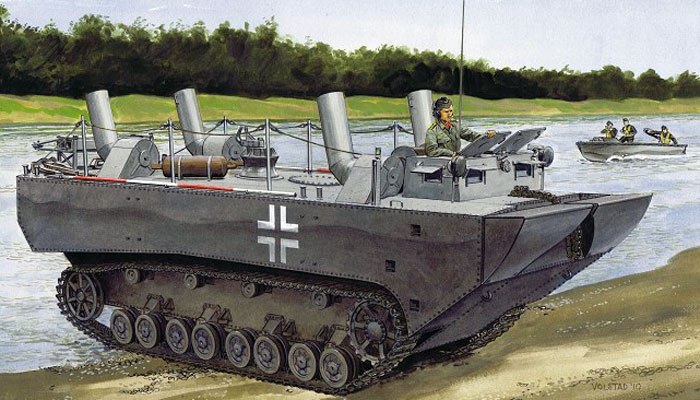|
|
|
|
| Home > Reviews > German > Dragon Models Limited 1/35 scale ‘39-‘45 Series Kit No. 6625; Panzerfaerhe Gepanzerte Landwasserschlepper Prototype No. 1 - Smart Kit |
Panzerfaerhe Gepanzerte Landwasserschlepper Prototype No. 1 - Smart Kit
Reviewed by Cookie Sewell
Summary
| Stock Number and Description | Dragon Models Limited 1/35 scale ‘39-‘45 Series Kit No. 6625; Panzerfaerhe Gepanzerte Landwasserschlepper Prototype No. 1 - Smart Kit |
| Scale: | 1/35 |
| Media and Contents: | 654 parts (406 in grey styrene, 216 “Magic Track” single link tracks, 22 etched brass, 9 clear styrene, 1 length of nylon string) |
| Price: | Estimated to be USD$59.95 |
| Review Type: | First Look |
| Advantages: | First kit of this vehicle in this scale in styrene |
| Disadvantages: | Requires second prototype and decking to create a ferry (see text) |
| Recommendation: | Recommended for all German Pzkw. IV fans |
FirstLook
Like many combatant nations in WWII, the Germans were faced with river crossings roughly every 10 miles or so in European conditions. While taking bridges intact was obviously a priority and having engineer bridging units a must, they did not have any true means of amphibious crossings in hand during the war. The closest that they came was the boatlike Landwasserschlepper which was not armored. Later in the war Magirus was tasked with creating an armored replacement, and as such did produce two prototypes of the Panzerfaerhe (armored ferry) vehicle.
This it was not, as it was basically a large amphibious vehicle that carried any troops or cargo internally (ferries by their very nature carried their cargoes on open decking or at least on a main deck). As a result, experiments were made with a decking set that connected two of these vehicles together (and which was apparently tested with the two Magirus prototypes). But by that time (mid 1942) the Germans apparently saw such vehicles as a luxury they could no longer afford.
While several kits have recently been released of the curious Landwasserschlepper this is the first kit of the Panzerfaerhe to emerge. While it is an interesting vehicle on its own, as noted it requires two of them together to make an actual ferry and DML has shown advertising material they eventually plan to release just such a kit. (As an aside, note that the US was the only major combatant to create a true amphibious vehicle - the Roebling inspired LVT series - and get it into large-scale production. After the war the Soviets developed a number of amphibians and self-propelled tracked ferries such as the GSP.)
Other than the road wheel sets from its line of Pzkw. IV kits, DML’s ferry is new from the ground up. The kit comes with a foam bumper over the mounting bracket for the vehicle’s tow hook (seen in action on page 119 of the Chamberlain/Ellis/Jentz “Encyclopedia of German Tanks of World War Two” with an amphibious trailer in tow) which is a nice way to protect a fragile bracket.
Assembly is like that of the tank kits and begins with the suspension. It then moves to the propeller and propeller guard (I profess ignorance of the vehicle, for it seems to lack a rudder so I have no clue how it was steered!)
The deck and casemate are next, and while they all come with separate hatches there is zero interior anywhere on the model to show by leaving them open. The armored flaps on the front of the casemate may also be positioned.
The four vent stacks come next, and where they may be folded down for travel on the original the kit only provides for them to be shown in the up or operating position. With some work they can apparently be folded down. The winch and crane are next and neither one may be shown in any position but stowed.
Step 9 covers general assembly and adding the false bow (flotation chambers) before attaching the deck. The tracks are next (dark gray left, light gray right) as well as two curious lengths of chain at the front and rear of the hull. The tracks appear to be the earlier 38 cm tracks and lack traction cleats.
Note that there are a number of holes that must be drilled out during construction. Also this kit came with an addendum that notes if you leave the armored flaps open you need to cement the clear styrene windows into the openings from the inside.
The nylon line is used on this kit for the handrail stanchions and is not part of the winch or any tow cable.
Technical assistance was provided by Notger Schlegtendal, Tom Cockle and Gary Edmundsen.
Finishing directions are provided for Prototype 1 in the hands of an unknown unit (probably either the factory or a weapons/engineer test range). A set of white crosses are provided on a Cartograf sheet.
Overall this is a nice enough model on its own, but it appears it requires the Number 2 prototype and decking to complete it as a prototype tactical ferry. Given today’s prices that may be an expensive model.
Sprue Layout:
A 45x2 Pzkw. IV Generic drivers, idlers and return rollers
A 81x2 Pzkw. IV Generic road wheels and bogies
B 1 Panzerfaerhe - deck
B 12 Panzerfaehre - deck details, winch
C 39x2 Panzerfaerhe - deck details
C 12x2 Panzerfaerhe - exhausts and blowers
D 38 Panzerfaerhe - casemate and hull details, propeller
E 9 Panzerfaerhe - clear styrene
L 108 “Magic Track” single link - left
R 108 “Magic Track” single link - right
X 1 Panzerfaehre - lower hull
Y 1 Length of nylon string
MA 22 Etched brass
Thanks to Freddie Leung for the review sample.







